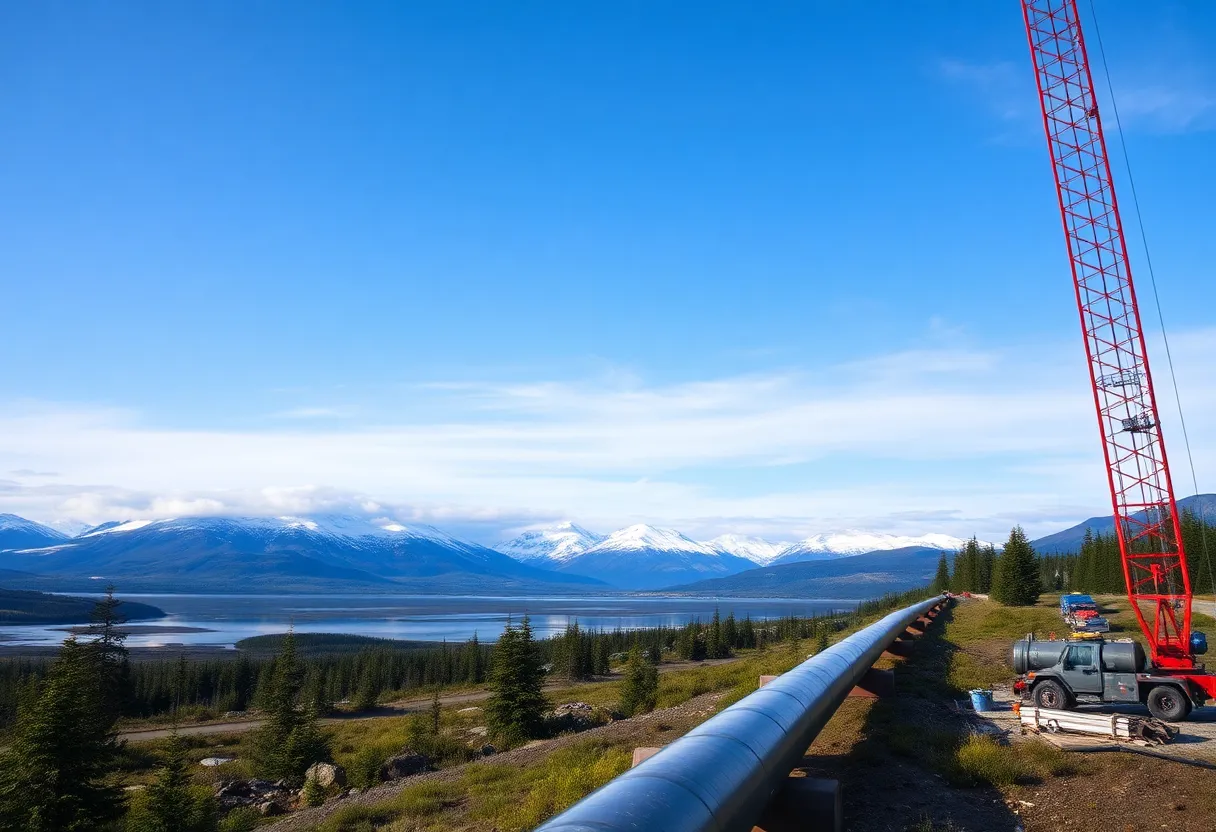Anchorage, Alaska, October 15, 2025
News Summary
Glenfarne Alaska LNG has announced plans to commence construction of its proposed pipeline in late 2026, aiming for operational status by mid-2029. The pipeline is expected to deliver approximately 3.5 billion cubic feet of gas per day, significantly enhancing Alaska’s LNG export capacity. Despite political backing, the project faces regulatory challenges and budgetary constraints as the state navigates financial difficulties. The company recently acquired a 75% stake in the project, which has seen past proposals falter due to financial and regulatory issues.
Anchorage, Alaska – Glenfarne Alaska LNG has announced plans to initiate construction of its proposed pipeline in late 2026, with the project expected to become operational by mid-2029. This timeline was discussed following a meeting between Glenfarne Alaska LNG President Adam Prestidge and Japanese Consul Kiyohiko Hamada, which involved representatives from 8 Star Alaska, a subsidiary of the Alaska Gasline Development Corporation (AGDC). While Glenfarne has put forth these projections, they do not yet have formal confirmation from the Japanese government.
The proposed pipeline will primarily follow the route of the Trans-Alaska Pipeline System and is designed to deliver around 3.5 billion cubic feet of gas per day. This development could significantly enhance Alaska’s capacity to export liquefied natural gas (LNG), as indicated by Interior Secretary Doug Burgum, who mentioned that construction could commence as early as 2026.
However, the project faces substantial regulatory challenges, with three necessary permits still pending. Additionally, Alaska is currently under financial strain, with Governor Mike Dunleavy recently vetoing various bills and cutting over $100 million from the state budget in response to decreased oil revenues. Amid these financial constraints, discussions about the pipeline’s potential have been ongoing in the Alaska Gasline Caucus, where company officials have suggested that construction should ideally start in mid-2026.
Political and Financial Context
The project has garnered political backing at both state and federal levels, highlighted by a pledge of support from former President Donald Trump, who emphasized the need to expand Alaska’s LNG capabilities. His administration’s focus included prioritizing the development of Alaska’s LNG potential through a series of executive orders.
Nonetheless, the project is not without criticism. Environmental concerns have been raised regarding the pipeline’s possible impact on the wildlife and traditional lands, which some community members and environmental groups remain apprehensive about. Furthermore, rising costs associated with the project and fluctuating oil prices coupled with market competition create skepticism about its overall feasibility.
Financial History and Company Stake
Glenfarne has not provided details regarding the total cost of the pipeline or its funding sources. Alaska has invested nearly $1 billion in gas line efforts over the past quarter-century. Recently, Glenfarne acquired a 75% stake in the project from AGDC, marking a significant shift in the management and direction of these efforts.
Past LNG proposals in Alaska suffered setbacks due to a combination of financial hurdles and regulatory delays. Despite these challenges, there is a notable level of support for the Glenfarne project, even in light of the apprehensions expressed by some segments of the community and environmental advocates.
As Alaska continues to weigh its options in terms of LNG exports, the Glenfarne Alaska LNG project stands as a critical focal point in discussions about the state’s energy future and economic recovery amid budget pressures and environmental considerations.
Frequently Asked Questions
What is the timeline for the Glenfarne Alaska LNG pipeline project?
Construction is set to begin in late 2026, with the project expected to be operational by mid-2029.
What are the major challenges facing the project?
The project faces regulatory hurdles with three permits still pending and has been impacted by budget pressures in Alaska.
How much natural gas is the pipeline expected to deliver?
The pipeline is designed to deliver approximately 3.5 billion cubic feet of gas per day.
Key Features of the Glenfarne Alaska LNG Project
| Feature | Details |
|---|---|
| Construction Start | Late 2026 |
| Operational Date | Mid-2029 |
| Gas Delivery Capacity | 3.5 billion cubic feet per day |
| Pending Permits | Three |
| State Budget Impact | Over $100 million cut |
| Company Stake | 75% acquired by Glenfarne from AGDC |
| Federal Support | Trump administration provided backing |
Deeper Dive: News & Info About This Topic
HERE Resources
Additional Resources
- Alaska News Source
- Wikipedia: Natural Gas in Alaska
- Anchorage Daily News
- Google Search: Alaska LNG Pipeline
- Rolling Stone
- Google Scholar: Alaska LNG Project
- New York Times
- Encyclopedia Britannica: Alaska LNG
- Reuters
- Google News: Alaska LNG Pipeline
Author: STAFF HERE PHOENIX WRITER
The PHOENIX STAFF WRITER represents the experienced team at HEREPhoenix.com, your go-to source for actionable local news and information in Phoenix, Maricopa County, and beyond. Specializing in "news you can use," we cover essential topics like product reviews for personal and business needs, local business directories, politics, real estate trends, neighborhood insights, and state news affecting the area—with deep expertise drawn from years of dedicated reporting and strong community input, including local press releases and business updates. We deliver top reporting on high-value events such as the Waste Management Phoenix Open, Cactus League Spring Training, and Arizona State Fair. Our coverage extends to key organizations like the Greater Phoenix Chamber of Commerce and Visit Phoenix, plus leading businesses in technology and healthcare that power the local economy such as Intel and Banner Health. As part of the broader HERE network, including HERETucson.com, we provide comprehensive, credible insights into Arizona's dynamic landscape.





